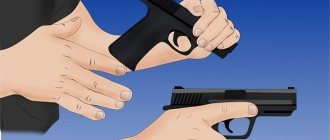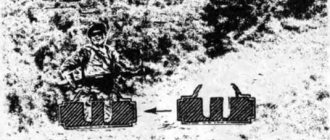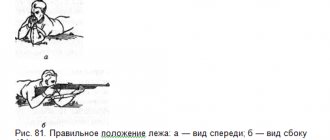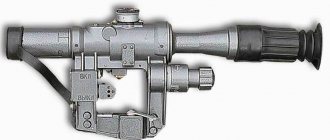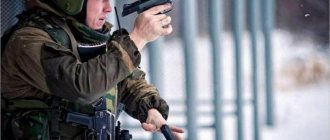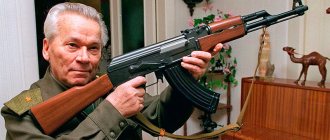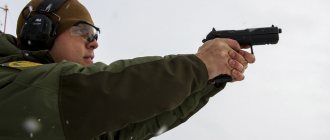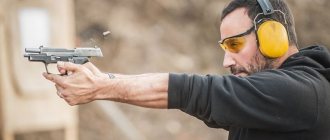The basics of shooting include theoretical principles that are necessary for understanding the processes occurring during shooting and mastering the techniques and rules of shooting.
Shot phenomenon
A shot is the ejection of a bullet (projectile) from the barrel under the action of powder gases formed during the combustion of a powder charge. It happens in a very short period of time. The strike of the firing pin on the cartridge primer produces a flame that ignites the powder charge. In this case, a large amount of highly heated gases is formed, which, increasing in volume, create high pressure, acting in all directions with equal force.
Under gas pressure, the bullet moves from its place, crashes into the rifling and receives rotational movement due to the rifling of the barrel.
The gunpowder continues to burn, the amount of gases in the barrel increases, and the bullet moves along the barrel with continuously increasing speed and is thrown out along the axis of the barrel.
Hot gases flowing out of the barrel following a bullet, when meeting air, form a flame and a shock wave, which is the source of sound when fired.
Further, the flight of the bullet in the air continues by inertia and largely depends on its initial speed. Initial speed The
initial speed of a bullet is the speed at which the bullet leaves the barrel - the speed of the bullet at the point of departure.
The initial speed of a bullet is one of the most important characteristics of the combat properties of a weapon. An increase in initial speed increases the range of a bullet, its penetrating and lethal effect, and reduces the influence of external conditions on its flight.
The magnitude of the initial bullet speed depends on:
- barrel length
- bullet mass
- powder charge mass
- other factors.
The longer the barrel (up to certain limits), the longer the powder gases act on the bullet and the greater its initial speed.
Weapon recoil action
characterized by the amount of speed and energy it has when moving backwards. The recoil speed of a weapon is approximately the same number of times less than the initial speed of a bullet, how many times the bullet is lighter than the weapon.
Penetrating and lethal effect of a bullet
Bullet penetration
— the ability of a bullet to penetrate a barrier (shelter) of a certain density and thickness.
Lethal effect of a bullet
- the effect of a bullet on a living organism, leading to its incapacitation. In this case, the body's absorption of the kinetic energy of a bullet is accompanied by the destruction of its protective tissues and vital organs. To damage vital human organs without special protection, the kinetic energy must be at least 78.5 J.
Direct shot and its practical significance
Straight shot
called a shot in which the flight path of the bullet does not rise above the aiming line above the target along its entire length. The range of a direct shot depends on the height of the target and the flatness of the trajectory. The higher the target and the flatter the trajectory, the greater the direct shot range and, therefore, the distance at which the target can be hit with one sight setting.
Its practical significance lies in the fact that in tense moments of battle, shooting can be carried out without rearranging the sight, while the aiming point in height will be selected along the lower edge of the target.
Caliber
Caliber is a numerical expression of the internal diameter of the bore, measured between the opposite rifling (in a rifled gun) and the walls (fields) in a smoothbore gun.
Why don't the caliber of the cartridge and the diameter of the bullet match?
In rifled weapons, caliber can be measured in two ways - by the bottom of the rifling or by their fields. The diameter of the bullet usually corresponds, with small tolerances, to the diameter along the bottom of the rifling.
In Russia, the caliber of a weapon is defined as the distance between opposite fields. In a number of other countries, the caliber is determined by the bottom of the rifling.
In most countries, caliber is measured in millimeters, for example 9.0mm, 6.5mm, 7.62mm, and so on, that is, these can be either whole or fractional numbers to the second decimal place. In the US and UK, caliber is measured in inches.
A cartridge is a device that combines a cartridge case, a projectile (bullet, shot) and a charge (powder or other substance), as well as a means of initiating a powder charge in the form of a capsule.
The initial speed of a bullet is the speed of the bullet at the muzzle of the barrel. The initial speed of a bullet is measured in meters per second (m/s). The initial speed of a bullet is the main characteristic when assessing the combat properties of a weapon. The higher the speed of a bullet, the greater its flight range, penetrating and lethal effect.
The target firing range is the distance from the muzzle of the barrel to the point of intersection of the aiming line and the bullet’s flight path.
GTO standard for air rifle shooting
To receive a gold, silver or bronze badge, you will have to score a certain number of points by participating in shooting competitions. It is worth noting that we are not talking about the number of points awarded by judges for hits on targets during the individual competition:
Men and women
Participants of the GTO, whose age is at least 18 years old, can test themselves in competitions in air rifle shooting from a sitting position (with their elbows resting on the table) or standing (at the athlete’s choice). Here is a list of steps and points required to receive a prize:
- 6, 7, 8 steps (men): gold – 30 points, silver – 25 points, bronze – 18 points;
- 6, 7, 8 steps (women): gold – 25 points, silver – 20 points, bronze – 15 points;
- 9, 10, 11 steps (men): gold – 25 points, silver – 20 points, bronze – 15 points;
- 9, 10, 11 steps (women): gold – 20 points, silver – 15 points, bronze – 10 points.
Points are calculated depending on what place the athlete received in the individual competition, how many hit points he scored (in relation to other participants) and how many penalty points he received for non-compliance with the rules. All this is very complicated and is calculated according to a certain scheme. However, the point remains the same - the more points you get, the higher the likelihood of getting gold.
Pupils
Schoolchildren of levels 1, 2 and 3 can only take part in pneumatic shooting competitions from a sitting position from a distance of 5 meters. Older participants (4th and 5th level) have the choice of shooting standing or sitting (distance 10 meters). In order to receive badges, you will have to score the following number of points:
- 1,2, 3rd stage (girls): gold – 10 points, silver – 15 points, bronze 20 points;
- 1st, 2nd, 3rd stage (boys): gold – 15 points, silver – 20 points, bronze 25 points;
- Stage 4, 5 (girls): gold – 15 points, silver – 20 points, bronze 25 points;
- 4th, 5th stage (boys): gold – 20 points, silver – 25 points, bronze 30 points.
Also, many parents of schoolchildren are concerned about the question of whether their children can take part in competitions without any permits or licenses. We answer: teachers and coaches bear full responsibility for their students, so no documents are required from students.
Stages
The firing cycle of multi-component complexes and weapons systems, in addition to the three main stages, includes numerous intermediate stages
The firing cycle is divided into three main stages, each of which, in turn, is divided into intermediate stages, the number of which increases in proportion to the increase in the number of integrated (involved) elements and the complexity of the weapon systems. For example, for modern air defense systems, the following main and intermediate stages can be distinguished:
1. Preparing to fire on a target
- Input of target designation;
- Switching on missiles for preparation;
- Search, detection, target acquisition for tracking;
- Identification of the target and determination of its nationality;
- Assigning missiles to target channels;
- Making a decision to fire at a target.
2. Firing the target
- Missile launch;
- Missile capture control;
- Missile guidance control.
3. Assessment of the results of the shelling Based
on a combination of signs.
Literature
- Russia (USSR) in local wars and military conflicts of the second half of the 20th century. / Ed. V. A. Zolotareva. — M.: Kuchkovo pole; Polygraph resources, 2000. - 576 p. — ISBN 5-86090-065-1.
- Volzhin A. N., Sizov Yu.
G. Fighting homing missiles. - M.: Voenizdat, 1983. - 144 p. - Zarakovsky G.M. et al.
Introduction to ergonomics. / Ed. V. P. Zinchenko. - M.: Sov. radio, 1974. - 352 p. - Zimin G.V. et al.
Handbook of an air defense officer. — 2nd ed., revised. and additional - M.: Voenizdat, 1987. - 512 p. - Loschilov I. N.
Computer technology in military affairs. - M.: Publishing House DOSAAF USSR, 1987. - 156 p. - Neupokoev F.K.
Anti-aircraft combat. - M.: Voenizdat, 1989. - 262 p. — ISBN 5-203-00177-4.
Choosing a shooting location
Modern Russian sights for small arms
130. The shooter takes the place indicated by the commander for firing, or chooses it independently.
Shooting from a carbine can be carried out from any place from which a target or a section of terrain where a target is likely to appear is visible. Depending on the situation, the place for shooting is chosen in a trench, trench, shell crater, ditch, behind a stone, stump. In a populated area, the place for shooting can be chosen in the window of a building, in the attic, in the foundation of a building, etc.
131. It is necessary to choose a place for shooting that provides the best visibility and fire, protects the shooter from enemy observation and allows convenient shooting techniques. You should not choose a place for shooting near prominent individual local objects, as well as on the ridges of hills.
Literature
- Russia (USSR) in local wars and military conflicts of the second half of the 20th century. / Ed. V. A. Zolotareva. — M.: Kuchkovo pole; Polygraph resources, 2000. - 576 p. — ISBN 5-86090-065-1.
- Volzhin A. N., Sizov Yu.
G. Fighting homing missiles. - M.: Voenizdat, 1983. - 144 p. - Zarakovsky G.M. et al.
Introduction to ergonomics. / Ed. V. P. Zinchenko. - M.: Sov. radio, 1974. - 352 p. - Zimin G.V. et al.
Handbook of an air defense officer. — 2nd ed., revised. and additional - M.: Voenizdat, 1987. - 512 p. - Loschilov I. N.
Computer technology in military affairs. - M.: Publishing House DOSAAF USSR, 1987. - 156 p. - Neupokoev F.K.
Anti-aircraft combat. - M.: Voenizdat, 1989. - 262 p. — ISBN 5-203-00177-4.
Application
While it is possible to calculate the firing cycle in theory and in practice even for the most primitive types of small arms and throwing weapons, such as a bow and sling, as a rule, the calculation of the firing cycle is carried out for more modern complex models of weapons and military equipment (complexes or systems) served by one and more operators - the personnel of units and subunits, from artillery guns to missile defense systems, served by hundreds and thousands of military personnel and civilian specialists as part of several military units and special institutions of the military-industrial complex. Individual firing elements (combat weapons) as part of complexes or weapons systems may have a different firing cycle. In relation to multi-component layered weapons systems (as well as fire systems organized on the ground depending on specific situational factors and terrain conditions), the firing cycles of their individual elements can overlap each other with varying degrees of synchronization as the target (targets) overcome various echelons of defense , - in relation to missile systems, this will mean that the launch of second-echelon missiles will begin before meeting the target of first-echelon missiles, third-echelon missiles - before meeting with the target of second-echelon missiles, etc.
Requirements for the instruction manual
Regulatory and technical acts establishing requirements for electronic regulations:
- GOST 2.601-2013 – describes the types of operational documents, requirements for them and completeness;
- GOST 2.610-2006 - establishes the rules for drawing up various operational documents, including operating instructions.
According to these standards, the manual must contain information about the design, description of operation, properties of the product, and instructions for its safe use. The description of use should not be limited to intended use only. It is necessary that it also includes rules for transportation, storage, maintenance and repair, assessment of technical condition, and information on proper disposal.
Additional requirements for the manual are described by TR CU 010/2011, in force since 2013. In particular, they relate to the safety characteristics of machinery and equipment. Thus, TR CU establishes the need to convey to consumers information about potential dangers during unacceptable operation. The instructions must specify the limitations of the conditions of use and the safety measures that must be taken when using the equipment.
GOST for registration of RE
According to the requirements of the standards - two specialized GOSTs, the OM must be drawn up according to the established template, taking into account all the recommendations contained in them, which are mandatory.
Standard 2.601-2013 allows for the preparation of manuals in electronic form, which means that they can be posted on the manufacturer’s website. Additionally, the requirements of GOST 2.051-2013 will apply to electronic electronic manuals, which reflects information on the rules for drawing up electronic design documentation.
The manual must be accompanied by detailed technical diagrams. And due to the similarity of the operating instructions with the product passport, the regulations allow their combination. In this case, the document will be called “Passport and Operating Manual”.
Structure and content of the document
According to GOST 2.610-2006, which establishes requirements for the content of the OM, it should consist of an introduction and the following sections:
- Part 1 – describes the equipment and its functions;
- 2 – contains information about intended use;
- 3 – indicates how maintenance should be carried out;
- 4 – reflects information about current repairs;
- 5 – specifies storage rules;
- 6 – describes information about proper transportation;
- 7 – contains information about recycling.
In the same GOST (number 2.610-2006) you can see examples of the design of the title page, a sample of entering data into different parts of the manual in tabular form.
Stages
The firing cycle of multi-component complexes and weapons systems, in addition to the three main stages, includes numerous intermediate stages
The firing cycle is divided into three main stages, each of which, in turn, is divided into intermediate stages, the number of which increases in proportion to the increase in the number of integrated (involved) elements and the complexity of the weapon systems. For example, for modern air defense systems, the following main and intermediate stages can be distinguished:
1. Preparing to fire on a target
- Input of target designation;
- Switching on missiles for preparation;
- Search, detection, target acquisition for tracking;
- Identification of the target and determination of its nationality;
- Assigning missiles to target channels;
- Making a decision to fire at a target.
2. Firing the target
- Missile launch;
- Missile capture control;
- Missile guidance control.
3. Assessment of the results of the shelling Based
on a combination of signs.
